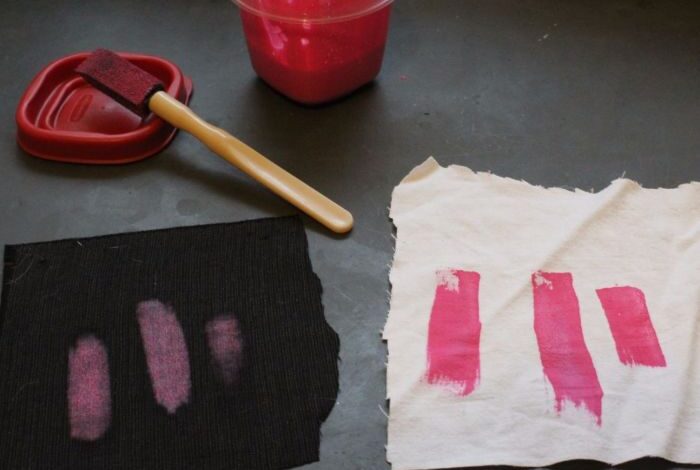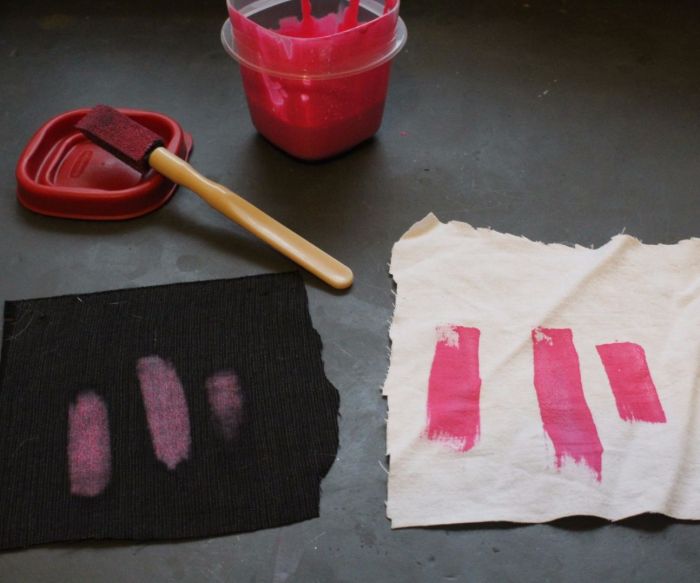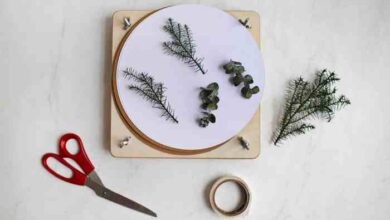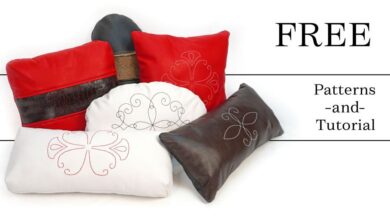
Make your own fabric with Martha Stewart paint sets the stage for a creative journey, allowing you to transform plain fabrics into personalized masterpieces. Whether you’re a seasoned crafter or a curious beginner, this project offers endless possibilities for expressing your unique style.
From vibrant patterns on clothing to stunning designs on home decor, the world of fabric painting opens up a whole new dimension of creativity. With the right tools and techniques, you can create personalized pieces that reflect your individual taste and add a touch of handcrafted charm to your life.
This guide will walk you through every step of the process, from choosing the right paint to mastering different painting techniques. We’ll explore the different types of fabric paint available, discuss the importance of preparing your fabric, and guide you through various painting methods to create unique designs.
We’ll also cover essential tips for setting the paint for durability, ensuring your creations last. Get ready to unleash your inner artist and create beautiful, personalized fabric masterpieces with Martha Stewart paint.
Fabric Painting with Martha Stewart Paint
Fabric painting is a fun and rewarding craft that allows you to personalize your clothing, home décor, and accessories. Using Martha Stewart fabric paint, you can create unique designs and patterns that reflect your style and personality. This paint is known for its vibrant colors, durable finish, and ease of use, making it ideal for both beginners and experienced crafters.One of the greatest benefits of making your own fabric is the ability to express your creativity and create custom pieces that are truly one-of-a-kind.
You can choose your own colors, patterns, and designs, allowing you to create items that perfectly match your taste and style. Furthermore, creating your own fabric can be a more sustainable option, as you can repurpose old clothing or fabric scraps into new and exciting pieces.
Materials Needed
Fabric painting requires a few essential materials. Here is a list of items you will need to get started:
- Martha Stewart Fabric Paint: Choose from a wide range of colors and finishes, including acrylic, fabric markers, and fabric crayons.
- Fabric: Select a fabric that is suitable for painting, such as cotton, linen, or silk. Avoid delicate fabrics like lace or chiffon, as they may not hold up well to the paint.
- Brushes: Use a variety of brush sizes to create different effects. For fine details, opt for smaller brushes, while larger brushes are ideal for filling in large areas.
- Palette Knife: This tool is helpful for mixing colors and applying paint in thick layers.
- Fabric Medium: This optional product helps to improve the paint’s adhesion to the fabric and prevents it from cracking or peeling.
- Work Surface: Choose a surface that can withstand paint spills, such as a plastic tablecloth or a piece of cardboard.
- Water: Keep a container of water handy for cleaning brushes and diluting paint.
- Paper Towels: Use paper towels to wipe away excess paint and clean up spills.
Choosing the Right Paint

The type of fabric paint you choose is crucial for the success of your project. Different paints have different properties, so it’s important to select the one that best suits your needs. Consider the fabric you’re using, the design you’re creating, and the level of durability you require.
Types of Fabric Paint
There are several types of fabric paint available, each with its own unique characteristics.
- Acrylic Fabric Paint:This is the most common type of fabric paint and is available in a wide range of colors. Acrylic paints are water-based, easy to use, and dry quickly. They are also relatively durable and washable, making them suitable for a variety of projects.
- Fabric Markers:Fabric markers are a convenient option for detailed designs and lettering. They are typically acrylic-based and offer good colorfastness and washability.
- Fabric Dye:Fabric dyes are used to permanently color fabric, offering a more subtle and blended effect than paint. They are available in liquid and powder forms and require a specific process for application.
- Specialty Fabric Paints:Specialty fabric paints are designed for specific applications, such as metallic finishes, glow-in-the-dark effects, or fabric stiffening. These paints offer unique properties and can enhance the creativity of your projects.
Paint Properties
- Durability:Durability refers to the paint’s ability to withstand wear and tear. Some paints are more durable than others, making them suitable for items that will be frequently washed or used. Acrylic paints generally offer good durability, while fabric markers may fade over time with repeated washing.
- Washability:Washability refers to the paint’s ability to withstand washing without fading or cracking. Washable paints are ideal for projects that will be laundered frequently.
- Colorfastness:Colorfastness refers to the paint’s ability to retain its color over time. Some paints are more colorfast than others, meaning they are less likely to fade in sunlight or with repeated washing.
Choosing the Best Paint for Your Project
- Fabric Type:The type of fabric you’re using will influence the type of paint you choose. For example, natural fibers like cotton and linen are generally more absorbent than synthetic fibers like polyester and nylon. You may need a different type of paint for each type of fabric.
Making your own fabric with Martha Stewart paint is a fun and creative way to personalize your home decor. You can use it to create unique patterns and designs on everything from pillowcases to curtains. If you’re looking for a simpler way to add some personality to your walls, you might want to try this easy washi tape wall art.
Once you’ve mastered the art of fabric painting, you can even incorporate your custom-made fabric into your wall art for a truly unique look.
- Design:The design you’re creating will also influence your paint choice. For example, if you’re creating a detailed design with fine lines, you may want to use fabric markers. If you’re creating a large, bold design, you may want to use acrylic fabric paint.
- Durability Requirements:If you’re creating a project that will be frequently washed or used, you’ll need to choose a durable paint. Acrylic paints are a good option for this type of project.
Preparing the Fabric
Getting your fabric ready for painting is crucial to ensure your artwork adheres well and lasts. Proper preparation involves pre-washing and ironing to remove any impurities and create a smooth surface for the paint. You can also enhance paint adhesion with fabric medium.
Pre-Washing and Ironing
Pre-washing your fabric is essential to remove any sizing, dyes, or finishes that may interfere with the paint’s adherence. Ironing helps create a smooth surface, allowing the paint to spread evenly and preventing wrinkles from showing through the paint.
- Pre-wash the fabric: Wash the fabric according to its care label, using a mild detergent and cool water. Avoid fabric softeners, as they can create a barrier between the fabric and the paint.
- Dry the fabric completely: Allow the fabric to air dry completely, or tumble dry on a low setting. Avoid using high heat, as it can shrink or damage the fabric.
- Iron the fabric: Iron the fabric on a low setting, using a pressing cloth to protect the fabric from the heat. This will help to remove any wrinkles and create a smooth surface for painting.
Using Fabric Medium
Fabric medium is a special solution that enhances the paint’s adhesion to the fabric, making it more durable and less likely to crack or fade. It also helps to create a smoother finish and prevent the paint from bleeding.
Important:Always test the fabric medium on a hidden area of the fabric before applying it to the entire piece. Some fabric mediums can change the color or texture of the fabric.
- Mix the fabric medium with paint: Follow the manufacturer’s instructions for mixing the fabric medium with the paint. Generally, you’ll need to mix a small amount of fabric medium with a larger amount of paint.
- Apply the mixture to the fabric: Use a brush or sponge to apply the paint mixture to the fabric. Allow the paint to dry completely before handling the fabric.
Painting Techniques
Now that you’ve chosen your fabric and paint, it’s time to get creative! There are many different techniques you can use to paint fabric, each with its own unique look and feel. Here’s a breakdown of some popular techniques:
Freehand Painting
Freehand painting is the most basic and versatile technique. It allows you to create any design you can imagine, limited only by your imagination and skill. This method is perfect for creating unique and personalized designs.You can use brushes of various sizes and shapes to create different effects.
For example, a fine-tipped brush is great for detailed work, while a wider brush is better for filling in large areas.
Making your own fabric with Martha Stewart paint is a fun and creative way to personalize your home decor. It’s all about adding a personal touch, just like the delicate scent of roses in a whipped rose shaving cream diy can elevate a simple bath routine.
With Martha Stewart’s paint, you can transform plain fabric into unique masterpieces, whether it’s a tablecloth for your dining room or a pillowcase for your bedroom.
For best results, use light, even strokes and let the paint dry completely between coats.
Stenciling, Make your own fabric with martha stewart paint
Stenciling is a great way to create intricate designs and patterns on fabric. It involves using a stencil, which is a sheet of material with a design cut out, to transfer the design onto the fabric. Stencils come in a wide variety of designs, from simple geometric shapes to complex floral patterns.
You can even create your own stencils using cardstock or acetate.
To use a stencil, place it on the fabric and secure it with painter’s tape. Apply the paint through the cutouts using a sponge or brush.
Stamping
Stamping is a fun and easy way to add patterns and textures to fabric. You can use a variety of stamps, such as rubber stamps, foam stamps, or even potatoes cut into shapes.
To stamp fabric, dip the stamp in paint and press it onto the fabric. You can use different colors and stamps to create unique and interesting designs.
Setting the Paint
You’ve created your masterpiece, but the work isn’t over yet! Setting the paint is crucial to ensuring your fabric creation lasts and looks its best. This step helps the paint become permanent and resistant to fading, cracking, and washing.There are several methods for setting fabric paint, each with its own benefits and drawbacks.
The best choice depends on the type of paint you used, the fabric you’re working with, and the level of durability you need.
Heat Setting
Heat setting is the most common and reliable method for setting fabric paint. This process uses heat to cure the paint, making it more permanent and washable. Here’s how to heat set your fabric paint:* Preheating the Iron:Preheat your iron to the highest setting that is safe for your fabric.
Always check the care label of your fabric for specific instructions.
Ironing
Place a thin piece of fabric, like a cotton sheet, over your painted fabric. This will protect the paint from direct contact with the iron. Iron over the painted area for 3-5 minutes, applying firm, even pressure.
Cooling
Allow the fabric to cool completely before handling it.
Heat setting is recommended for most acrylic paints, but it’s essential to check the paint manufacturer’s instructions for specific recommendations.
Air Drying
Air drying is an alternative method for setting fabric paint, particularly for paints that are labeled as “air-dry” or “permanent.” This method requires time and patience, as the paint needs to dry completely before it becomes durable. * Drying Time:The drying time for air-dry paints varies depending on the brand, thickness of the paint, and environmental factors like humidity and temperature.
Making fabric with Martha Stewart paint is such a fun way to personalize projects. You can create unique patterns and designs that reflect your style. And if you’re looking for another creative outlet, try making a easy magnetic photo puzzle tutorial.
It’s a great way to preserve memories and can be a fun activity for the whole family. Once you’ve mastered the fabric painting, you can even use your creations to make personalized puzzle pieces for your next photo project!
Generally, it can take 24-48 hours for the paint to fully cure.
Placement
Place your painted fabric in a well-ventilated area, away from direct sunlight or heat sources.
Air drying is a good option for projects that don’t require immediate durability, like smaller crafts or decorative items.
Project Ideas
Now that you’ve mastered the basics of fabric painting with Martha Stewart paint, let’s dive into some inspiring project ideas to unleash your creativity. From clothing to home decor, the possibilities are endless! We’ll explore projects suitable for various skill levels, providing step-by-step instructions and visual examples to guide you along the way.
Beginner-Friendly Projects
These projects are perfect for those new to fabric painting, allowing you to practice your skills and experiment with different techniques.
- Personalized Tote Bag:A simple and practical project, a personalized tote bag is a great way to add a touch of your style to your everyday essentials. Choose a plain canvas tote bag and use fabric paint to create a design, quote, or monogram.
You can use stencils for a crisp design or freehand it for a more artistic look.
- Painted Pillowcases:Give your bedroom a personalized touch with painted pillowcases. Choose a simple design, such as geometric patterns, stripes, or floral motifs, and use fabric paint to bring your vision to life.
- Custom Kitchen Towels:Add a pop of color and personality to your kitchen with custom-painted kitchen towels. Choose a design that reflects your style, such as a simple floral pattern, a fun animal print, or a whimsical quote.
Intermediate Projects
These projects require a bit more skill and detail, but are still manageable for those with some experience in fabric painting.
- Upcycled Denim Jacket:Give an old denim jacket a new lease on life with fabric paint. You can create a unique design by adding patches, embellishments, or even painting a full-blown artwork onto the jacket.
- Painted Tablecloth:Transform a plain tablecloth into a statement piece with fabric paint. You can create a geometric pattern, a floral design, or even a scene from your favorite landscape.
- Custom Sneakers:Make your sneakers stand out from the crowd with a personalized design. You can use fabric paint to create stripes, polka dots, abstract patterns, or even paint your favorite characters onto the shoes.
Advanced Projects
These projects require advanced skills and techniques, but offer the opportunity to create truly unique and impressive pieces.
- Fabric Wall Art:Create a stunning piece of fabric wall art by painting a complex design onto a large canvas. You can use fabric paint to create a realistic landscape, a vibrant abstract piece, or a portrait.
- Custom Curtains:Give your windows a personalized touch with custom-painted curtains. You can create a simple pattern, a bold statement design, or even a scene from your favorite movie.
- Painted Clothing:Take your fashion game to the next level with painted clothing. You can create unique designs on t-shirts, dresses, pants, and more. Be sure to use high-quality fabric paint and follow the instructions carefully to ensure your designs are long-lasting.
Troubleshooting: Make Your Own Fabric With Martha Stewart Paint

Fabric painting, like any creative endeavor, can present its share of challenges. Don’t fret if your initial attempts don’t go exactly as planned; these are common hiccups that can be easily addressed.
Fabric Paint Bleeding
Fabric paint bleeding is a common issue that can occur when the paint isn’t allowed to dry completely before being exposed to water or friction. This can lead to the paint spreading beyond its intended area and creating an unwanted blurry effect.
- Allow the paint to dry completely: Ensure the paint is fully dry before washing or ironing the fabric. A good rule of thumb is to wait at least 24 hours for the paint to cure fully.
- Use a fabric medium: Fabric mediums are specifically designed to help prevent bleeding and improve the paint’s adhesion to the fabric. They can be added to the paint or used as a sealant after the paint has dried.
- Choose the right fabric: Some fabrics are more prone to bleeding than others. Natural fabrics like cotton and linen tend to absorb more paint, which can lead to bleeding. Synthetics like polyester are generally less prone to bleeding.
- Use a fabric marker or pen: For delicate details or lines, fabric markers or pens can be a good alternative to liquid paint. These markers are designed to prevent bleeding and provide a more precise application.
Fabric Paint Cracking
Cracking can occur when the paint is applied too thickly or when the fabric is stretched or moved before the paint has dried completely. This can result in a less-than-desirable finish, with visible cracks in the paint.
- Apply thin layers of paint: Multiple thin layers of paint will dry more evenly and reduce the risk of cracking.
- Use a fabric medium: Fabric mediums can help to create a more flexible paint film, reducing the likelihood of cracking.
- Allow the paint to dry completely: Do not stretch or move the fabric until the paint is fully dry.
Fabric Paint Fading
Fading can happen over time due to exposure to sunlight, washing, or even just general wear and tear.
- Use a fabric medium: Fabric mediums can help to improve the paint’s lightfastness and prevent fading.
- Wash the fabric inside out: Washing the fabric inside out can help to protect the paint from direct contact with the washing machine’s agitator.
- Avoid using bleach or harsh detergents: These can damage the paint and cause it to fade.
- Avoid direct sunlight: Sunlight can cause the paint to fade over time. Store your fabric paintings in a cool, dark place when not in use.






